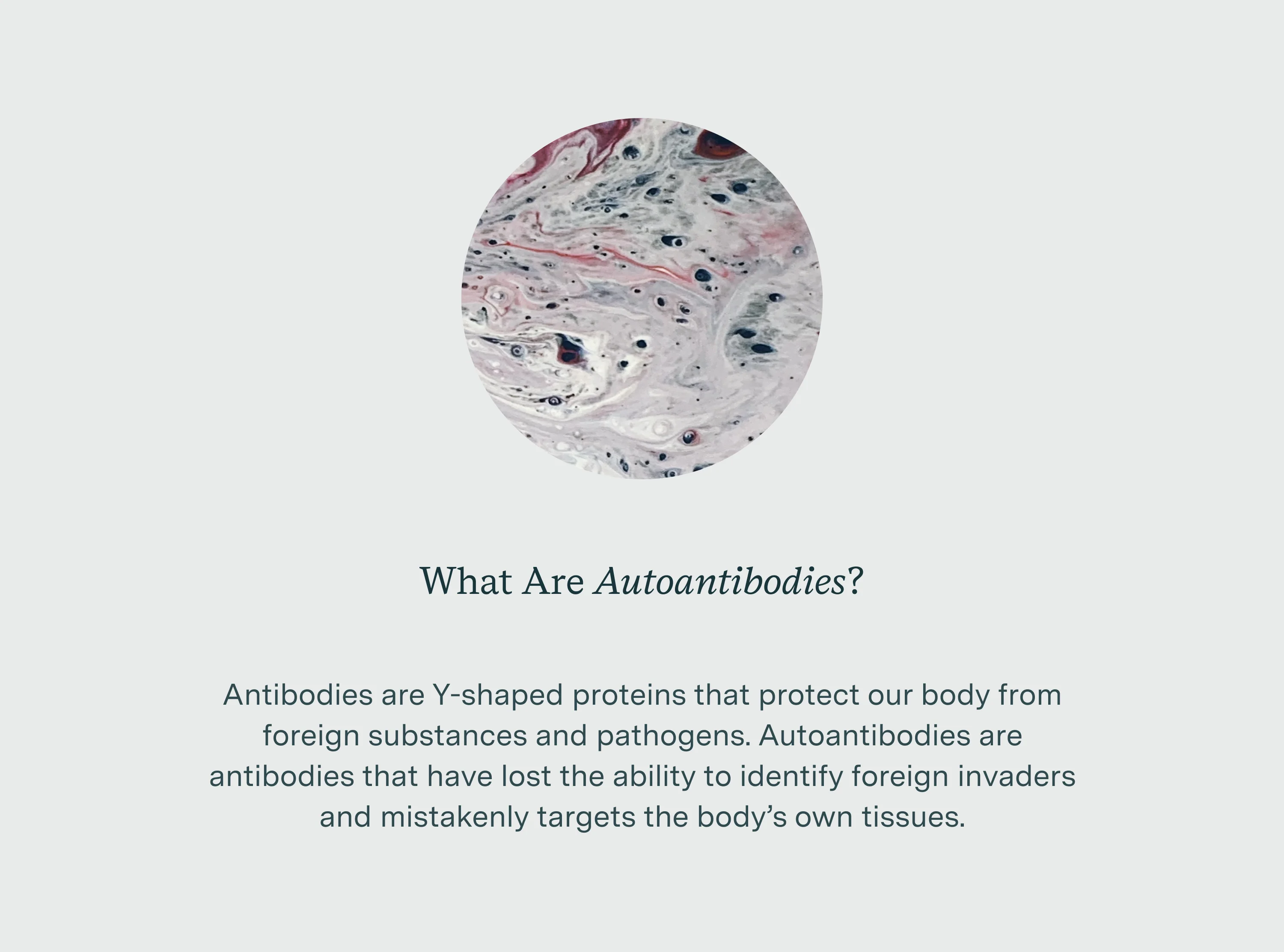Antibodies are critical for protecting us from disease-causing bacteria and viruses, but antibodies that target our own bodies can lead to autoimmune disease. In this comprehensive guide, we’ll discuss what autoantibodies are, as well as some common types of autoantibodies and autoimmune diseases.
What Are Antibodies?
Antibodies, or immunoglobulins, are Y-shaped proteins produced by white blood cells known as B lymphocytes, or B cells. Antibodies make up about 20% of the total protein content of plasma, the part of blood that is left after red and white blood cells and platelets are removed. (Source)

What Do Antibodies Do?
Antibodies find pathogens and other foreign substances that have entered the body, stick to them, and signal other members of the immune system to come help eliminate them.
Antibodies recognize foreign invaders by molecules the foreigners carry called antigens. Each antibody fits a specific antigen, and the introduction of a new antigen causes B cells to produce new antibodies to match it. This is called the adaptive, or acquired, immune response — the immune system adapts to new challenges.
Where in the body antibodies do their work is determined by their isotype. (Source)
Antibody Isotypes
Antibodies are formed of strings of smaller proteins known as chains. Light chains are each made up of about 220 amino acids, and heavy chains are each made up of about 440 amino acids. The structure of the heavy chains determine what isotype, or class, of immunoglobulin an antibody is. (Source)
Human antibody heavy chains have 5 isotypes:
- IgM antibodies are sometimes called “natural antibodies” because they aren’t specific to any individual antigen and are the first to respond to a novel threat. (Source)
- IgA antibodies protect mucous membranes in particular. They are the predominant isotype found in colostrum and breast milk. (Source)
- IgD antibodies have been identified but we don’t know much about them or what they do.
- IgE antibodies are associated with allergies and parasitic infections. While allergies in general are not beneficial to health, IgE antibodies seem to treat tumors as allergens, suggesting they hold promise in cancer treatment. (Source)
- IgG antibodies are the smallest and, with 4 subtypes, the most numerous antibodies. They pass easily into tissues all over the body and are the only antibodies that cross the placenta. (Source)
What Are Autoantibodies?
The role of antibodies is to protect the body from pathogens and other substances that enter the body from the outside. For antibodies to work properly, the immune system must be able to distinguish between “self” and “nonself” — that is, to tell the difference between foreign invaders and the cells, proteins, and other substances that belong in the body.
Antibodies that lose this ability and mistakenly target the body’s own tissues are called autoantibodies. Autoantibodies may bind with antigens on many different substances in the body, including DNA, RNA, fats, and proteins. These antigens may be found on the surface of cells, inside cells, or in the fluid between cells. In the most common systemic autoimmune diseases, autoantibodies target molecules inside the cell. (Source)
How Autoantibodies Are Activated
Research suggests the onset of autoimmunity involves an interplay of different contributing factors, including genetic predisposition, lifestyle, and environmental exposures. There is evidence for the “multiple hit” theory, which states that one “hit” causes autoantibodies to begin forming, and then at least one other “hit” is needed to activate the autoantibodies so they start attacking. (Source)
These hits may include:
Failure to Clear Apoptotic Debris
Apoptosis is the pre-programmed death of a cell at the end of its life. When a normal cell dies, it presents molecules on its membranes to signal immune cells called phagocytes to come clear it away. If these molecules are changed in a way that causes them to appear to be “nonself,” the immune system may see them as threats and autoimmunity may be activated. Similarly, apoptosis of abnormal cells may release antigens that stimulate an autoimmune response. (Source)
Modification of Self-Antigens by Inflammation
Another theory is that inflammation in the body causes changes in self-antigens that lead to an autoimmune response. This initiates a vicious cycle in which inflammatory modification of self-antigens causes injury to targeted cells, which are then damaged so they release more antigens into circulation, which leads to more injury and more inflammation. (Source)
Infection With a Cross-Reacting Virus
Another possibility under research is that exposure to a virus that presents antigens to the immune system that mimic or resemble self-antigens may stimulate autoantibodies to attack the body’s own cells or other tissues. (Source)

Some Autoantibodies May Be Natural
The B cells that produce antibodies start out in the blood marrow and mature in the spleen, a small organ tucked up under the stomach, after which they can become activated as part of an immune response elsewhere in the body. B cells that might react to the body’s own tissues generally don’t make it into circulation, but some do slip through. For this reason, it isn’t unusual for healthy people to have some “natural” autoantibodies in their blood. It is thought that natural autoantibodies are present from birth. (Source, Source)
What’s the Connection Between Autoantibodies and Autoimmune Diseases?
While some autoantibodies are natural and they may be present even if you don’t have an autoimmune disease, they can cause autoimmune disease if you are susceptible. The presence of autoantibodies can be a sign that you are genetically predisposed to an autoimmune disease.
Autoimmune disease is a general term used to describe any condition in which the immune system attacks and destroys healthy cells in the body by mistake. This can affect any tissue or organ in the body, including the skin, joints, blood vessels, muscles, and nervous system.
Although there are over 80 different types of autoimmune diseases, the most common include psoriasis, rheumatoid arthritis, autoimmune thyroid disease (Hashimoto’s and Graves’ diseases), and celiac disease. (Source)
Many autoimmune diseases associated with autoantibodies in the blood are long term and chronic. There may be a relationship between the amount of autoantibodies detected in the blood and the severity of the autoimmune disease. In some autoimmune diseases, such as type 1 diabetes and thyroiditis, autoantibodies may be detected years before any symptoms appear. (Source)
How Can Testing for Autoantibodies Be Helpful?
Autoantibodies can be used as markers of autoimmune disease activity. In diseases with a long onset, such as type 1 diabetes and thyroiditis, autoantibodies may be detected before symptoms become noticeable. Early testing for autoantibodies can help predict whether and when symptoms are likely to occur, sometimes providing an opportunity to forestall disease through preventive therapy and avoidance of environmental triggers. (Source)
Autoantibodies can also be used to determine whether or not a condition is due to an autoimmune disorder, helping guide treatment and management of symptoms.

.svg)
.png)













.webp)



.png)

 (1).webp)









 (1).jpeg)

.webp)
.webp)

.webp)

 (2).webp)

%201 (1).webp)

 2 (1).webp)




.svg)
.svg)